Entry Database : PDB / ID : 3kckTitle A Novel Chemotype of Kinase Inhibitors Tyrosine-protein kinase JAK2 Keywords / / / / / / / / / / / / / / Function / homology Function Domain/homology Component
/ / / / / / / / / / / / / / / / / / / / / / / / / / / / / / / / / / / / / / / / / / / / / / / / / / / / / / / / / / / / / / / / / / / / / / / / / / / / / / / / / / / / / / / / / / / / / / / / / / / / / / / / / / / / / / / / / / / / / / / / / / / / / / / / / / / / / / / / / / / / / / / / / / / / / / / / / / / / / / / / Biological species Homo sapiens (human)Method / / / Resolution : 2.2 Å Authors Zuccola, H.J. / Wang, T. / Ledeboer, M.W. Journal : Bioorg.Med.Chem.Lett. / Year : 2010Title : A novel chemotype of kinase inhibitors: Discovery of 3,4-ring fused 7-azaindoles and deazapurines as potent JAK2 inhibitors.Authors : Wang, T. / Ledeboer, M.W. / Duffy, J.P. / Pierce, A.C. / Zuccola, H.J. / Block, E. / Shlyakter, D. / Hogan, J.K. / Bennani, Y.L. History Deposition Oct 21, 2009 Deposition site / Processing site Revision 1.0 Nov 24, 2009 Provider / Type Revision 1.1 Jul 13, 2011 Group Revision 1.2 Nov 6, 2024 Group Data collection / Database references ... Data collection / Database references / Derived calculations / Structure summary Category chem_comp_atom / chem_comp_bond ... chem_comp_atom / chem_comp_bond / database_2 / pdbx_entry_details / pdbx_modification_feature / struct_conn / struct_ref_seq_dif / struct_site Item _database_2.pdbx_DOI / _database_2.pdbx_database_accession ... _database_2.pdbx_DOI / _database_2.pdbx_database_accession / _struct_conn.pdbx_leaving_atom_flag / _struct_ref_seq_dif.details / _struct_site.pdbx_auth_asym_id / _struct_site.pdbx_auth_comp_id / _struct_site.pdbx_auth_seq_id
Show all Show less
 Open data
Open data Basic information
Basic information Components
Components Keywords
Keywords Function and homology information
Function and homology information Homo sapiens (human)
Homo sapiens (human) X-RAY DIFFRACTION /
X-RAY DIFFRACTION /  SYNCHROTRON /
SYNCHROTRON /  FOURIER SYNTHESIS / Resolution: 2.2 Å
FOURIER SYNTHESIS / Resolution: 2.2 Å  Authors
Authors Citation
Citation Journal: Bioorg.Med.Chem.Lett. / Year: 2010
Journal: Bioorg.Med.Chem.Lett. / Year: 2010 Structure visualization
Structure visualization Molmil
Molmil Jmol/JSmol
Jmol/JSmol Downloads & links
Downloads & links Download
Download 3kck.cif.gz
3kck.cif.gz PDBx/mmCIF format
PDBx/mmCIF format pdb3kck.ent.gz
pdb3kck.ent.gz PDB format
PDB format 3kck.json.gz
3kck.json.gz PDBx/mmJSON format
PDBx/mmJSON format Other downloads
Other downloads 3kck_validation.pdf.gz
3kck_validation.pdf.gz wwPDB validaton report
wwPDB validaton report 3kck_full_validation.pdf.gz
3kck_full_validation.pdf.gz 3kck_validation.xml.gz
3kck_validation.xml.gz 3kck_validation.cif.gz
3kck_validation.cif.gz https://data.pdbj.org/pub/pdb/validation_reports/kc/3kck
https://data.pdbj.org/pub/pdb/validation_reports/kc/3kck ftp://data.pdbj.org/pub/pdb/validation_reports/kc/3kck
ftp://data.pdbj.org/pub/pdb/validation_reports/kc/3kck Links
Links Assembly
Assembly
 Components
Components Homo sapiens (human) / Gene: JAK2 / Plasmid: pBEV1 / Cell line (production host): Sf9 insect cells / Production host:
Homo sapiens (human) / Gene: JAK2 / Plasmid: pBEV1 / Cell line (production host): Sf9 insect cells / Production host: 
 X-RAY DIFFRACTION / Number of used crystals: 1
X-RAY DIFFRACTION / Number of used crystals: 1  Sample preparation
Sample preparation SYNCHROTRON / Site:
SYNCHROTRON / Site:  ALS
ALS  / Beamline: 5.0.2 / Wavelength: 1 Å
/ Beamline: 5.0.2 / Wavelength: 1 Å Processing
Processing FOURIER SYNTHESIS / Resolution: 2.2→20 Å / Cor.coef. Fo:Fc: 0.934 / Cor.coef. Fo:Fc free: 0.877 / WRfactor Rfree: 0 / WRfactor Rwork: 0 / FOM work R set: 0.743 / SU ML: 0.192 / SU R Cruickshank DPI: 0.352 / SU Rfree: 0.271 / Isotropic thermal model: Isotropic / Cross valid method: THROUGHOUT / σ(F): 0 / σ(I): 0 / ESU R: 0.352 / ESU R Free: 0.271 / Stereochemistry target values: Engh & Huber
FOURIER SYNTHESIS / Resolution: 2.2→20 Å / Cor.coef. Fo:Fc: 0.934 / Cor.coef. Fo:Fc free: 0.877 / WRfactor Rfree: 0 / WRfactor Rwork: 0 / FOM work R set: 0.743 / SU ML: 0.192 / SU R Cruickshank DPI: 0.352 / SU Rfree: 0.271 / Isotropic thermal model: Isotropic / Cross valid method: THROUGHOUT / σ(F): 0 / σ(I): 0 / ESU R: 0.352 / ESU R Free: 0.271 / Stereochemistry target values: Engh & Huber Movie
Movie Controller
Controller



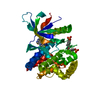
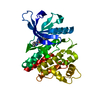
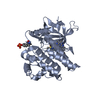
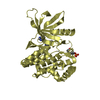


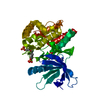

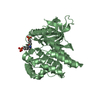
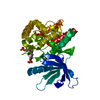
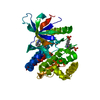
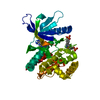
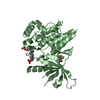

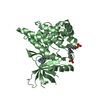
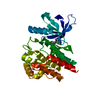


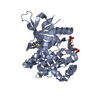

 PDBj
PDBj














